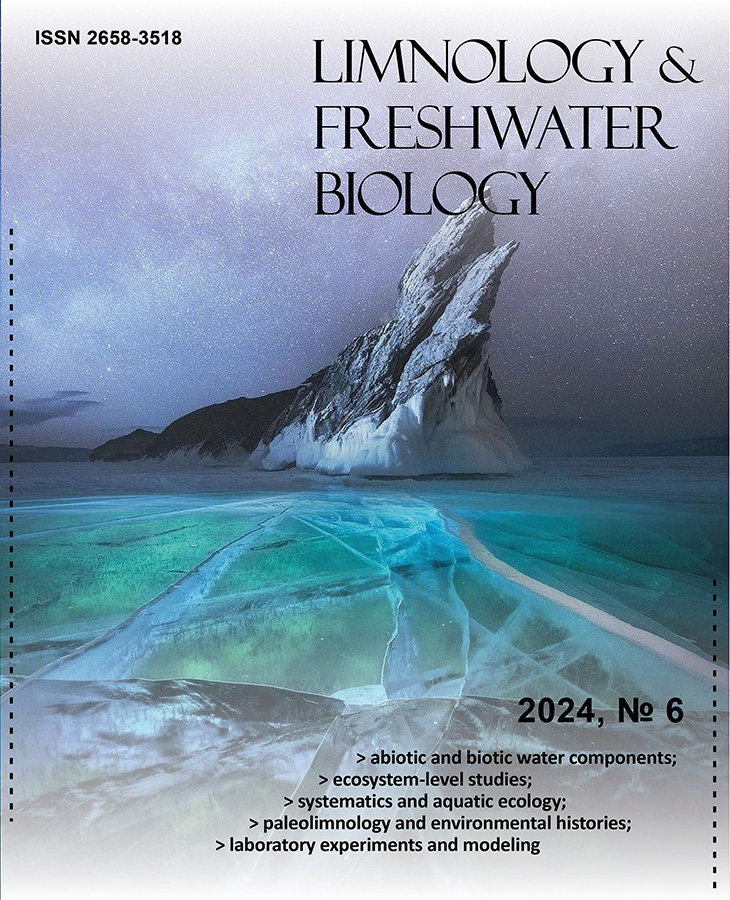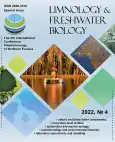Cladocera remains in reconstructions of past ecological conditions of the Yamal Peninsula
- Authors: Ibragimova A.G.1,2, Nigmatullin N.M.1, Nigamatzyanova G.R.1, Salnikova E.Y.1, Frolova L.A.1
-
Affiliations:
- Kazan Federal University
- A.N. Severtsov Institute of Ecology and Evolution of the Russian Academy of Sciences
- Issue: No 4 (2022)
- Pages: 1426-1428
- Section: Articles
- URL: https://journal-vniispk.ru/2658-3518/article/view/289353
- DOI: https://doi.org/10.31951/2658-3518-2022-A-4-1426
- ID: 289353
Cite item
Full Text
Abstract
The aim of this study is to explore the Cladocera community from the bottom sediments of small unnamed lake (21-Ya-02B) whilst attempt to reconstruct the ecological and climatic conditions for the Yamal Peninsula. In total, remains of 37 taxa were identified in bottom sediments of the lake. Cladocera community in the lower layers at the column is represented by low taxonomic abundance and typical northern species. On the depth of 65-40 cm the maximum number of taxa was identified, which allows it to be considered the temperature optimum zone of Cladocera. Changes in the upper layers of the column may indicate climate warming in the study area and, as a consequence, thawing of permafrost.
Full Text
1. Introduction
Recent decades have been characterized by noticeable climate change occurring in the Arctic faster and on a larger scale than in the rest of the world (Nigamatzyanova et al., 2021; Fefilova et al., 2022). Warming occurs synchronously for the Western Arctic region with short-term fluctuations, with both increasing and decreasing average annual temperatures observed. Climate warming is accompanied by an increase in annual precipitation (Shirokov and Vasiliev, 2019). Studies of lakes bottom sediments are of particular importance for reconstructing the ecological and climatic conditions of the past, whilst also assessing the current state of lakes (Smol et al., 2005). Algal and invertebrate remains (Chironomidae and Cladocera) are among the most common paleo indicators in lake sediments that provide reliable records of changes in water quality, habitat and catchment processes (Smol et al., 2005; Frolova et al., 2016; Ibragimova et al., 2020). The aim of this study is to explore the Cladocera community from the bottom sediments of small unnamed lake (21-Ya-02B), which is close to Lake Tabortato, whilst attempt to reconstruct the ecological and climatic conditions for the Yamal Peninsula.
2. Materials and methods
The Yamal Peninsula is located above the Arctic Circle, between the Kara Sea to the north and West, Baidaratskaya Bay in the southwest, and Obskaya Bay in the east. The territory is generally flat, hilly in the north, and elevated in the central part, elongated in the meridional direction, with elevations up to 100 m above sea level. The surface is cut in varying degrees by river and ravine network, heavily marshy and waterlogged. The Yamal Peninsula is located in a permafrost zone, a zone of tundra that changes from south to north from a narrow strip of forest tundra to arctic tundra. The climate of the peninsula is harsh, winter lasts 8-9.5 months (Atlas..., 2004). The study lake is located in the southwest of the Yamal peninsula (N 68˚09’53.8’’, E 68˚57’36.1’’). The lake is round and small, coastal vegetation includes small bushes, moss and grass. The bottom of the lake is muddy. In July 2021, specialists of Kazan Federal University collected a column of bottom sediments of the lake using Gravity corer. The depth of sampling of the bottom sediment column was 4.3 m, the length of the column was 67 cm. For Cladocera analysis, bottom sediment samples were sliced in 1 cm increments. Thus, for Cladocera analysis 35 samples of the bottom sediments were selected using a method of sample preparation improved by Korhola and Rautio (2001). In each sample 200 specimens were identified at minimum. The maximum number of headshields, carapaces or postabdomens of a single taxon was used to calculate the total number of specimens in the sample. Identification of the Cladocera remains was carried out using an Olympus BX41 (Olympus Corporation, Japan) (magnification x100-400) light microscope along with specialized keys for identification subfossil (Szeroczyńska and Sarmaja-Korjonen, 2007) and modern Cladocera (Kotov et al., 2013) Statistically significant stratigraphic zones were identified using CONISS cluster analysis of the Tilia/TiliaGraph software.
3. Results
In total, remains of 37 taxa belonging to 5 families of Cladocera (Chydoridae, Bosminidae, Daphniidae, Sididae, Macrothricidae) were identified in bottom sediments of the unnamed lake. The species diversity is mainly represented by the remains of the family Chydoridae. According to the stratigraphic diagram of Cladocera taxa distribution in bottom sediments of the studied lake, 4 faunistic zones can be distinguished. In the lower part of the column (Zone I, 70-65 cm) the least number of taxa - 15 taxa - was identified. Alonella nana - 34.49 %, Chydorus cf. sphaericus - 24.45 %, Eubosmina (Bosmina) cf. longispina - 17.35 % are subdominants. Cladocera community in this zone is represented by typical northern species. Zone II (65-40 cm) shows the greatest species diversity, where remains of 32 taxa were identified. The greatest number of remains belongs to A. nana -27.73 %, C. cf. sphaericus -26.96 %, E. (B.) cf. longispina (18.41 %) remains. The increase in taxonomic diversity is due to the development of the littoral complex. In zones I-II the remains of Sida crystallina, Rhynchotalona latens, Camptocercus fennicus are found, which are associated with cold climate and low content of organic matter. In zone III, significant changes in the ratio of identified taxa are observed: the role of dominant in the Cladocera community is played by E. (B.) cf. longispina (73.87 %). The share of C. cf. sphaericus (14.83 %), Acroperus sp., Alona guttata tuberculata/ Alona rectangula pulchra, A. nana (0.41 %) decreases. In zone IV, a decrease in taxonomic diversity was observed - 18 taxa were identified. The dominance of E. (B.) cf. longispina (50.3 %) is noted, C. cf. sphaericus (27.49 %) is subdominant. The proportion of representatives of Alona s.lat. increases, while the remains of representatives of the genus Alonella are not found in Zone IV.
4. Discussion
Low taxonomic diversity of the lower part of the bottom sediment column is common for lakes of glaciogenic origin (Frolova and Ibragimova, 2015). Zone I is represented by remains of typical northern species associated with low temperatures. There is an increase in taxonomic diversity in the upper layers. The Сladocera community of this zone indicates the cold climate during this period. The maximum number of remains of A. nana, classified as a subarctic taxon, is noted here. However, this species is also strongly associated with vegetation and has a pronounced ecological preference for dystrophic lakes with sphagnum mosses (Fryer, 1968). The presence of higher aquatic vegetation and oligotrophic conditions in the reservoir is indicated by the remains of S. crystallina (Flössner, 2000). The maximum number of taxa was identified in zone II, which allows it to be considered the temperature optimum zone of Cladocera, although the remains of northern species (C. fennicus, R. latens, A. harpae, A. nana) testify to low temperatures in the study region. The increase in taxonomic diversity is due to the appearance of taxa inhabiting overgrown areas of water bodies. In zone III the dominant communities change, a significant increase in the proportion of pelagic E. (B.) cf. longispina may indicate a change in temperature regime in the study area and, as a consequence, thawing of permafrost. There is a decrease in the proportion of littoral species and species associated with vegetation. Northern species reduce their abundance in favor of warm-water forms: C. fennicus is replaced by C. rectirostris. In zone IV, taxonomic diversity continues to decrease, indicating changing conditions in the watershed and in the lake. The increase in the proportion of C. cf. sphaericus at the present stage of the lakes is often associated with eutrophication (Flössner, 2000), as well as with the release of organic matter during permafrost thawing. The increase in the proportion of B. longirostris in the surface sediments is also classified as a sign of an increase in the trophic status of the lake. Similarly, to those observed in previous investigations in other tundra lakes within Russia (Frolova and Ibragimova, 2015; Frolova et al., 2016; Ibragimova et al., 2020)
5. Conclusions
Significant changes in subfossil Cladocera community of the studied unnamed lake on the Yamal Peninsula are noted from a depth of 40 cm of the bottom sediments: there is a change in the dominant complex, an increase in the proportion of pelagic taxa and taxa associated with eutrophication. The above may be a consequence of climate change and thawing of permafrost in the study area.
Acknowledgments
The field work and laboratory analysis were supported by a grant from the Russian Science Foundation (No. 20-17-00135). Statistical analysis was funded by the Strategic Academic Leadership Program of Kazan Federal University. Ibragimova A. was supported by a scholarship from the President of the Russian Federation.
Conflict of interest
The authors declare no conflict of interest.
About the authors
A. G. Ibragimova
Kazan Federal University; A.N. Severtsov Institute of Ecology and Evolution of the Russian Academy of Sciences
Author for correspondence.
Email: Ais5_ibragimova@mail.ru
Russian Federation, Kremlyovskaya Str., 18, Kazan, 420008; Leninsky Prospekt Str., 33, Moscow, 119071
N. M. Nigmatullin
Kazan Federal University
Email: Ais5_ibragimova@mail.ru
Russian Federation, Kremlyovskaya Str., 18, Kazan, 420008
G. R. Nigamatzyanova
Kazan Federal University
Email: Ais5_ibragimova@mail.ru
Russian Federation, Kremlyovskaya Str., 18, Kazan, 420008
E. Yu. Salnikova
Kazan Federal University
Email: Ais5_ibragimova@mail.ru
Russian Federation, Kremlyovskaya Str., 18, Kazan, 420008
L. A. Frolova
Kazan Federal University
Email: Ais5_ibragimova@mail.ru
Russian Federation, Kremlyovskaya Str., 18, Kazan, 420008
References
- Atlas Yamalo-Nenetskogo avtonomnogo okruga. 2004. Omsk: Omskaya kartograficheskaya fabrika.
- Fefilova E.B., Dubovskaya O., Frolova L.A. et al. 2022. Biogeographic patterns of planktonic and meiobenthic fauna diversity in inland waters of the Russian Arctic. Freshwater Biology 67: 78-94. doi: 10.1111/fwb.13624
- Flössner D. 2000. Die Haplopoda und Cladocera (ohne Bosminidae) Mitteleuropas [The Haplopoda and Cladocera (excluding Bosminidae) of Central Europe]. Leiden: Backhuys Publishers. (in German)
- Frolova L.A., Ibragimova A.G. 2015. Karcinologicheskij analiz donnyh otlozhenij ozer Kilometrovoe i Kotovo Harbejskoj sistemy (Bol’shezemel’skaya tundra). Trudy Karelʹskogo Nauchnogo Tsentra Rossiyskoy Akademii Nauk. Seriya Limnologiya [Proceedings of the Karelian Scientific Center of the Russian Academy of Sciences. Series Limnology] 5: 5-17. (in Russian)
- Frolova L., Ibragimova A., Fedorova I. 2016. Stratigraphy of Cladocera in a core from a Yamal Peninsula lake (Arctic Russia). In: 16th International Multidisciplinary Scientific GeoConference SGEM 2016, pp. 579-587.
- Fryer G. 1968. Evolution and adaptive radiation in the Chydoridae (Crustacea: Cladocera): a study in comparative functional morphology and ecology. Philosophical Transactions of the Royal Society B 254(795): 221-385. doi: 10.1098/rstb.1968.0017
- Ibragimova A., Frolova L., Gareev B. et al. 2020. Changes in the Cladocera community within the bottom sediments of a small tundra lake (the Yamal Peninsula, Erkuta River Basin). In: 4th Kazan Golovkinsky Stratigraphic Meeting “Sedimentary Earth Systems: Stratigraphy, Geochronology, Petroleum Resources”, pp. 34-40.
- Korhola A., Rautio M. 2001. Cladocera and other branchiopod crustaceans. In: Smol J.P., Birks H.J.B., Last W.M. (Eds.), Tracking environmental change using lake sediments. Vol. 4: Zoological indicators. Dordrecht: Kluwer Academic Publishers, pp. 125-165. doi: 10.1007/0-306-47671-1
- Kotov A., Forró L., Korovchinsky N.M. et al. 2013. World checklist of freshwater Cladocera species. URL: http://fada.biodiversity.be/group/show/17
- Nigamatzyanova G.R., Nigmatullin N.M., Gareev B.I. et al. 2021. Preliminary reconstruction of climate changes and vegetation cover inferred from pollen study of the arctic lake bottom sediments from the southwestern part of the Yamal Peninsula. In: 21st International Multidisciplinary Scientific GeoConference SGEM 2021, pp. 415-421.
- Shirokov R.S., Vasiliev A.A. 2019. Bathymetric and bottom temperatures GIS of the Barents and Kara Seas. Natural Resource Management, GIS & Remote Sensing 1(1): 21-27.
- Smol J.P., Wolfe A.P., Birks J. et al. 2005. Climate-driven regime shifts in the biological communities of arctic lakes. PNAS 102(12): 4397-4402. doi: 10.1073/pnas.0500245102
- Szeroczyńska K., Sarmaja-Korjonen K. 2007. Atlas of Subfossil Cladocera from Central and Northern Europe. Świecie: Friends of the Lower Vistula Society.
Supplementary files










